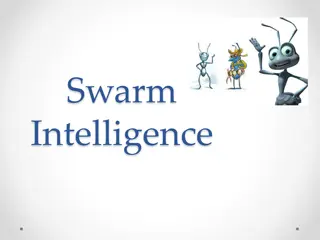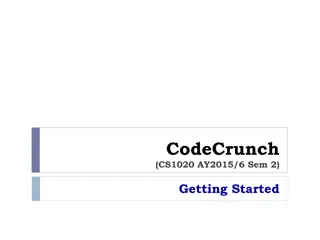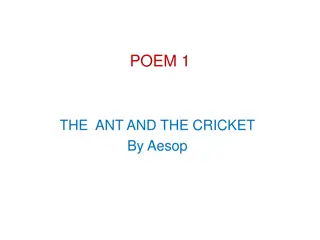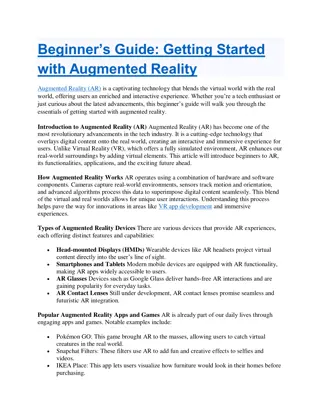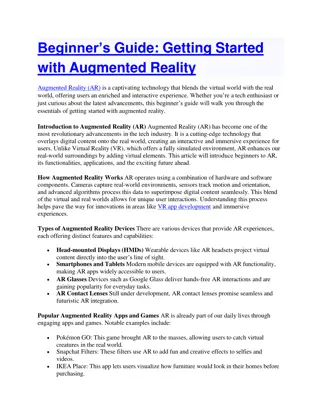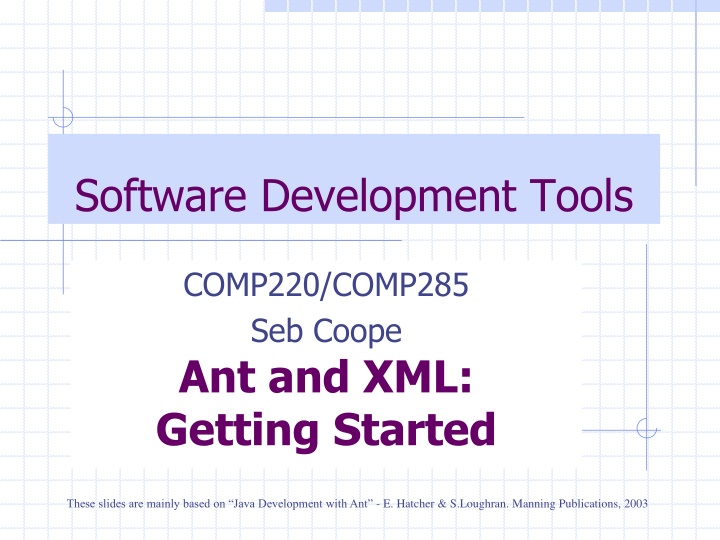
Getting Started with Ant and XML for Java Development
Explore the basics of using Ant for Java development, including installation, setting up directories, writing Ant build files, compiling Java source code, and running your first build. Start your journey into efficient software development practices with Ant and XML integration.
Download Presentation

Please find below an Image/Link to download the presentation.
The content on the website is provided AS IS for your information and personal use only. It may not be sold, licensed, or shared on other websites without obtaining consent from the author. If you encounter any issues during the download, it is possible that the publisher has removed the file from their server.
You are allowed to download the files provided on this website for personal or commercial use, subject to the condition that they are used lawfully. All files are the property of their respective owners.
The content on the website is provided AS IS for your information and personal use only. It may not be sold, licensed, or shared on other websites without obtaining consent from the author.
E N D
Presentation Transcript
Software Development Tools COMP220/COMP285 Seb Coope Ant and XML: Getting Started These slides are mainly based on Java Development with Ant - E. Hatcher & S.Loughran. Manning Publications, 2003
Getting Started with ANT First, check that Ant is installed: 2
Getting Started with ANT Let us generate a Javasource file Main.java and a build file build.xml in the same, base directory C:\comp220_285\lecture005 We will use and extend this directory structure in the future considerations. Use the same naming of directories. In the lab, you will use the drive H: instead of C: 3
Getting Started with ANT BUILD with Ant the following Java program Main.java public class Main { public static void main(String args[]) { for(int i=0;i<args.length;i++) { System.out.println(args[i]); } } We want: } Store this file in directory called src 1. Compile it 2. Archive (create a .jar file; later), 3. Execute (later). 4
Writing Ant build file Create a filebuild.xmlcontaining only one target: <?xml version="1.0"?> <project name="firstbuild" default="compile" > <target name="compile"> <javac srcdir= src" includeAntRuntime="no"/> <echo>compilation complete!</echo> </target> </project> It compiles all Java source code in and below the src directory src"according to javac Ant attribute. srcdir="." It is usually best to set above includeAntRuntime to "false" or "no" so the script's behaviour is not sensitive to the environment in which it is run. 5
Running you first build RunAnt at the command prompt from this directory: Look at the compiled file in the directory firstbuild. Repeat this run again. Do you see any difference with the above run? Can you explain it? 6
Running you first build Ant compiled all Java source in the current directory (and all its subdirectories, if any) and printed a success <echo> message afterwards. Now you can see the resulting Main.class in C:\comp220_285\lecture005\src This looks trivial, but Ant can do much more! 7
XML and ANT The contents of the above file build.xml is an XML document. We will need only most elementary concepts ofXML. Read more, for example, in Annotated XML Specification (Bray 1998) http://www.xml.com/axml/axml.html or a simple tutorial in http://www.w3schools.com/default.asp 8
XML and ANT Any XML document is a kind of well-formed and nested bracket expression (with some data in between) like ((()())()) where brackets are balanced. Each left "(" has corresponding ")" to the right of it, etc. No overlapping between any two bracket expressions (something here) and (something else here) is allowed. Either one such expression is part of another (nesting), or they do not intersect (do not overlap). 9
XML and ANT In XML so called start, or opening tags like <project>, <target>, <javac> play the role of opening bracket "(", and corresponding end, or closing tags </project>, </target>, </javac> play the role of closing bracket ")". 10
XML and ANT XML expression of the form <anytag> anything here </anytag> are called elements Elements can nest can have sub-elements (children), etc. For example, in ANTbuild file the main <project> element can have <target> sub-elements (children) which can have <task> sub-sub-elements (grandchildren). 11
XML and ANT Element <anytag></anytag> with no text or subelements between the tags is called an empty element , and is abbreviated as <anytag/> Note, that / is used at the end of the tag to denote the empty element. If / appears at the beginning of a tag then this tag is considered as closing tag. If / appears at the end of a tag then this tag denotes an empty element. 12
XML and ANT Any text can be written between tags, like here: <echo>compilation complete!</echo> Such a text is not considered as sub-element. (Sub)elements should always start and end with matching tags. 13
XML and ANT Any XML document should have exactly one root element (ignore the auxiliary first line <?xml version="1.0"?>). The root of any ANT build file is always a <project> element. The root element contains all other elements as sub-...-sub-elements. This leads to tree representation of any XML document. 14
Ttee representation of the above build.xml file Caution!! Do not mix such a tree representation of a build file with the graph of dependencies between targets considered earlier for another build file. <project name= firstbuild default= compile > The goals and the meanings of these two different representations are quite different. <target name= compile > <echo> <javac srcdir= . > Compilation complete! 15
The ANT conceptual model A project contains targets, targets contain tasks; there can be further nesting The XML representation of a build file is a tree The above root project element contains only one target compile , which contains two tasks<javac> and <echo> 16
XML attributes in Ant build files Start tags can optionally contain attributes like name, default, srcdir in the above file build.xml. Example:<target name="compile"> This is the start tag of a target with the name "compile". Attributes should have some text values like name="firstbuild" default="compile" name="compile" srcdir= src" 17
Ant vs. HTML In general, XML tags, attributes and their values may be arbitrary. However, in HTML and Ant: - tags, attribute names and values of some attributes have usually a predefined meaning. Of course, in HTML and Ant this meaning is completely different: - visualizing in HTMLvs. - executing and otheractions by tasks in Ant. Say, srcdir= src" means that the source directory, i.e., directory containing source code files (*.java), is defined as the directory src" (with respect to the base directory discussed later). 18
XML elements in Ant build files The compile target element <target name="compile"> <! - empty element javac: --> <javac srcdir= src" includeAntRuntime="no"/> <echo>compilation complete!</echo> </target> Comment ignored by Ant consists of two task subelements<javac> and <echo> <javac> compiles all source files from the current directory downward <echo> prints "compilation complete!" when the build process reaches that far. If the compilation task fails then the build will fail and haltbefore the echo message gets printed. 19
Summary Ant build file has one root <project> element containing several <target> elements (there are some exceptions discussed later). A target is a single stage in the build process. It has a unique name arbitrary string (avoid spaces!). A target consists of several task sub-elements. Ant is extensible : new useful tasks and other tags may be added to it See Ant Tasks in http://ant.apache.org/manual/index.html for description of currently implemented Anttasks, their attributes and nested elements that configure the task, as well as handy examples. 20





